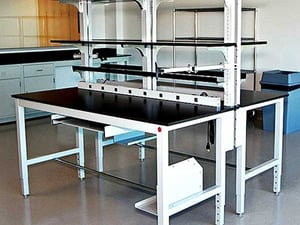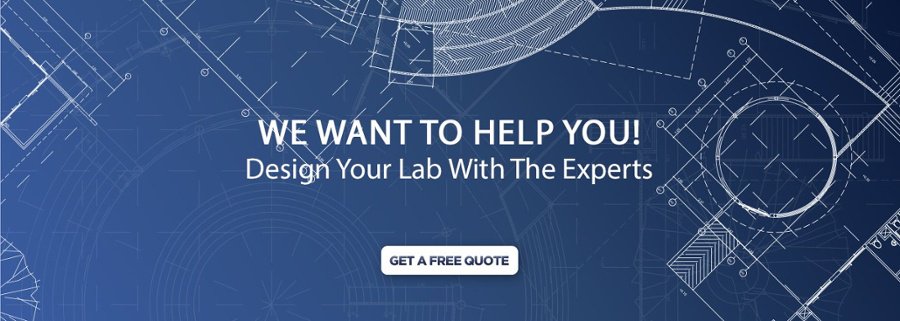With tariffs, fluctuating shipping rates and international supply chain challenges making headlines, the true cost of purchasing laboratory furniture from overseas can be far more complex than it appears.
While lower price tags on imported laboratory tables, benches and workstations might seem appealing at first glance, those numbers often don’t tell the whole story.
Beyond the initial quote, buyers may face steep long-term costs, from unexpected fees and delivery delays to frequent repairs, replacements or even complete renovations. Factoring in the Total Cost of Ownership (TCO), rather than just the upfront price, helps ensure your investment delivers lasting value rather than future headaches.
What Is Total Cost of Ownership?

Total cost of ownership (TCO) is a financial estimate that factors the purchase price of an asset, the costs of operation and end-of-life disposal.
When choosing among alternatives in a purchasing decision, buyers should look not just at a lab chair or lab table’s short-term purchase price, but also at its long-term price, which is its total cost of ownership. The item with the lower total cost of ownership will be the better value in the long run.
When assessing competing proposals and quotes for new laboratory furniture, lab managers often choose the most inexpensive contender that checks off all the necessary boxes.
On the surface, this line of reasoning makes perfect sense. After all, why pay more than necessary for something as simple as laboratory furniture? Why not choose the least expensive product as long as you believe it satisfies your minimum requirements?
For many managers, showing an ability to cost-effectively implement a build-out or refurbishment can be perceived as an indicator of negotiating acumen and managerial competence. Yet, counter-intuitively, investing more upfront can deliver better long-term financial results for your organization.
Factors Affecting Laboratory Furniture Costs
If your evaluation only considers the initial purchase and installation costs, you assume that every other subsequent cost is going to be equal among competing products. This is rarely the case. The initial purchase price never encompasses the total cost of ownership of an asset.
A single-minded focus on short-term cost management is often short-sighted— an action that saves money at the beginning. But, over a longer period of time, this thinking results in more money being spent or wasted than was saved in the first place.
Total cost of ownership considers not only the cost of acquisition whenever a capital investment is made, but also factors in the hidden costs of any transaction. Here are a few to consider:
- Shipping and Handling: Freight charges, taxes, packaging or special handling, assembly and installation are significant factors affecting your purchase.
- Durability: Industrial furniture that can withstand the operational rigors of your lab environment are less expensive in the long run than those that must be replaced regularly because they are of lower quality.
- Maintenance: Maintenance crews, replacement parts and lost work hours negate any cost savings from cheaper furniture.
- Replacement Parts: Access to replacement parts is crucial. If your manufacturer is overseas, what is the turnaround time to get parts and shipping cost?
- Upgradability: Industrial workbenches that are manufactured to enable upgrades avoid becoming obsolete as your facility requirements change.
- Flexibility: Customization and modularity are important factors when designing your lab. As your needs change, can your furniture change with your new requirements?
- Quality: High-quality furniture leads to higher efficiency and productivity and decreased downtime and worker frustration.
- Warranties: These are not standard. It’s good to know upfront what is covered and for how long.
Laboratory Furniture Is An Investment
It’s easy to view your laboratory furniture as a line item on your balance sheet, but it has one of the most significant impacts on your lab.
Factoring in other variables including downstream costs is important for organizations that realize furniture is an investment. Total cost of ownership allows a more complete assessment of a purchasing decision and examines not only the acquisition cost of your capital purchase, but maintenance and replacement costs that are likely to affect the productivity of your lab.
A true life cycle cost analysis includes the initial purchase cost and any cost to maintain the product over the life cycle time period. Initial purchase cost, installation charges, maintenance costs, mid-life modification costs, and the actual expected life must be factored into the analysis to yield the true financial outlay for your company.
In other words, choosing cheap lab furniture may end up costing more in the long run!
If you purchase an inexpensive workbench, table or workstation that is not designed to withstand the requirements of your lab environment, it may break down sooner than anticipated, and you will have to replace it with another or be subjected to workspace shutdowns or loss of functionality.
This is a drag on your results and will affect your bottom line.
By subjecting yourself to inferior quality, you negate the initial savings of opting for the inexpensive furniture over a more expensive alternative designed to withstand heavy wear and tear.
Safety is another factor. Workstations that have electrical assemblies that are not UL Listed subject your labs to fire hazards. You don’t want to be the lab manager who is responsible for a disaster in your building because of the purchase of shoddy equipment.
What Top Laboratory Furniture Manufacturers Offer
When you partner with a top-tier lab furniture manufacturer, you're getting more than just equipment. You’re getting a long-term ally in building a functional, efficient and compliant lab.
Leading manufacturers understand the unique needs of different labs and offer a range of customization options to match your exact specifications. From dimensions and work surface materials to layout and utility integration, these companies can tailor lab benches, workstations and fume hoods to fit your workflow and facility design.
Top manufacturers also prioritize your timeline. They work closely with you to coordinate production and delivery schedules that align with your project goals, helping you avoid costly delays. Unlike overseas providers, domestic companies often offer faster turnaround times, more consistent communication and flexible scheduling … critical factors when you're working under tight deadlines.
Shipping and handling are handled with care. Your furniture is packed to minimize damage during transit, and high-quality U.S. manufacturers often work with trusted logistics partners to ensure shipments are secure and arrive in pristine condition.
Should anything go wrong, having a U.S.-based partner can make a world of difference. Customer service teams are easier to reach, more responsive and can resolve issues much faster, whether it’s a missing part, a damaged item or an unexpected adjustment.
Finally, many American manufacturers also offer installation services, compliance documentation and even long-term maintenance or support plans. These are value-added services that reduce stress and help protect your investment.
The best lab furniture manufacturers deliver not just quality products, but also peace of mind.
Bottom Line
The least expensive product might satisfy requirements the day it’s delivered and installed. But is it sufficiently “future proof?” For example, after six or nine months of use, does it develop a wiggle or does the finish wear off?
This is a simple example of how a low-cost solution can leave you in bind, becoming either unusable or a source of frustration for your technicians before the expected end of its useful life.
Purchasing high-quality American-made laboratory furniture is a smart choice. Thinking beyond purchase price and looking at the total cost of ownership will ensure that you make the very best decision for your organization and deliver financial results in the long run.


